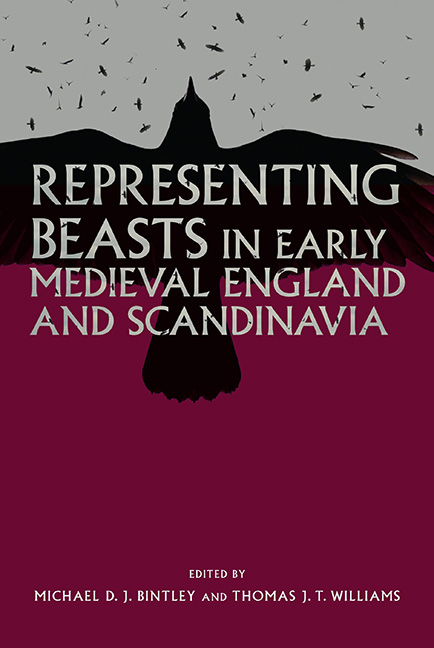Book contents
- Frontmatter
- Contents
- List of Figures and Tables
- Acknowledgements
- List of Contributors
- List of Abbreviations
- Introduction
- 1 Between Myth and Reality: Hunter and Prey in Early Anglo-Saxon Art
- 2 ‘(Swinger of) the Serpent of Wounds’: Swords and Snakes in the Viking Mind
- 3 Wreoþenhilt ond wyrmfah: Confronting Serpents in Beowulf and Beyond
- 4 The Ravens on the Lejre Throne: Avian Identifiers, Odin at Home, Farm Ravens
- 5 Beowulf’s Blithe-Hearted Raven
- 6 Do Anglo-Saxons Dream of Exotic Sheep?
- 7 You Sexy Beast: The Pig in a Villa in Vandalic North Africa, and Boar-Cults in Old Germanic Heathendom
- 8 ‘For the Sake of Bravado in the Wilderness’: Confronting the Bestial in Anglo-Saxon Warfare
- 9 Where the Wild Things Are in Old English Poetry
- 10 Entomological Etymologies: Creepy-Crawlies in English Place-Names
- 11 Beasts, Birds and Other Creatures in Pre-Conquest Charters and Place-Names in England
- Index
- Anglo-Saxon Studies
4 - The Ravens on the Lejre Throne: Avian Identifiers, Odin at Home, Farm Ravens
Published online by Cambridge University Press: 11 June 2021
- Frontmatter
- Contents
- List of Figures and Tables
- Acknowledgements
- List of Contributors
- List of Abbreviations
- Introduction
- 1 Between Myth and Reality: Hunter and Prey in Early Anglo-Saxon Art
- 2 ‘(Swinger of) the Serpent of Wounds’: Swords and Snakes in the Viking Mind
- 3 Wreoþenhilt ond wyrmfah: Confronting Serpents in Beowulf and Beyond
- 4 The Ravens on the Lejre Throne: Avian Identifiers, Odin at Home, Farm Ravens
- 5 Beowulf’s Blithe-Hearted Raven
- 6 Do Anglo-Saxons Dream of Exotic Sheep?
- 7 You Sexy Beast: The Pig in a Villa in Vandalic North Africa, and Boar-Cults in Old Germanic Heathendom
- 8 ‘For the Sake of Bravado in the Wilderness’: Confronting the Bestial in Anglo-Saxon Warfare
- 9 Where the Wild Things Are in Old English Poetry
- 10 Entomological Etymologies: Creepy-Crawlies in English Place-Names
- 11 Beasts, Birds and Other Creatures in Pre-Conquest Charters and Place-Names in England
- Index
- Anglo-Saxon Studies
Summary
‘God rewards those who favour the raven’
(modern Icelandic proverb).On 2 September 2009, an amateur archaeologist digging at Lejre in Denmark discovered a tiny silver and niello sculpture, only 17.5 mm high, of a person seated on a decorated throne and flanked by two ravens. It has been dated to the tenth century (the Viking Age). The drawing in Fig. 4.1 shows the sculpture from the side, with the back of a raven clearly visible. While not common, miniature metal chairs or thrones are not unknown in this period in Scandinavia; they are usually unoccupied and found in women's graves. Suggesting that such chairs are probably amulets, Fuglesang added (in 1989) that ‘so far, 13 examples are known from Sweden (including Gotland) and Denmark (including Bornholm). They date from the mid-Viking period (875/900–950/975) and have been connected by some archaeologists to the cult of Odin.’ The fact that someone sits on the Lejre throne is an unusual feature in the context of these miniatures. Moreover, while the collared beasts on the back of the throne are clearly ornamental, with their long necks continuing down into interlocked ribbons, the two birds flanking the seated figure are neither decorations nor part of the chair. Their size compared to that of the seated figure, their slightly bent but not hooked beaks, the detail of their wings with primaries crossed when at rest,5 and their intent attitude looking up at the human figure, are all realistic enough to allow one to identify them as corvids. In fact, some might find the realism of these birds, each only about a quarter of inch high, the most surprising detail of the sculpture.
These two birds, which are large relative to the person between them, perch on the armrests of the throne and gaze upward at the seated figure. Even had there not been a previous association of the miniature chairs with a cult of Odin, those who first saw the Lejre object would have been inclined to assume the person occupying the chair to be that god, because the sculpture appears to echo the Icelander Snorri Sturluson's famous description in his Prose Edda (c. AD 1200) of Odin's hall, his throne and his ravens:
There is also the great place called Valaskialf; it belongs to Odin. The gods built it and roofed it with pure silver.
- Type
- Chapter
- Information
- Publisher: Boydell & BrewerPrint publication year: 2015
- 2
- Cited by



